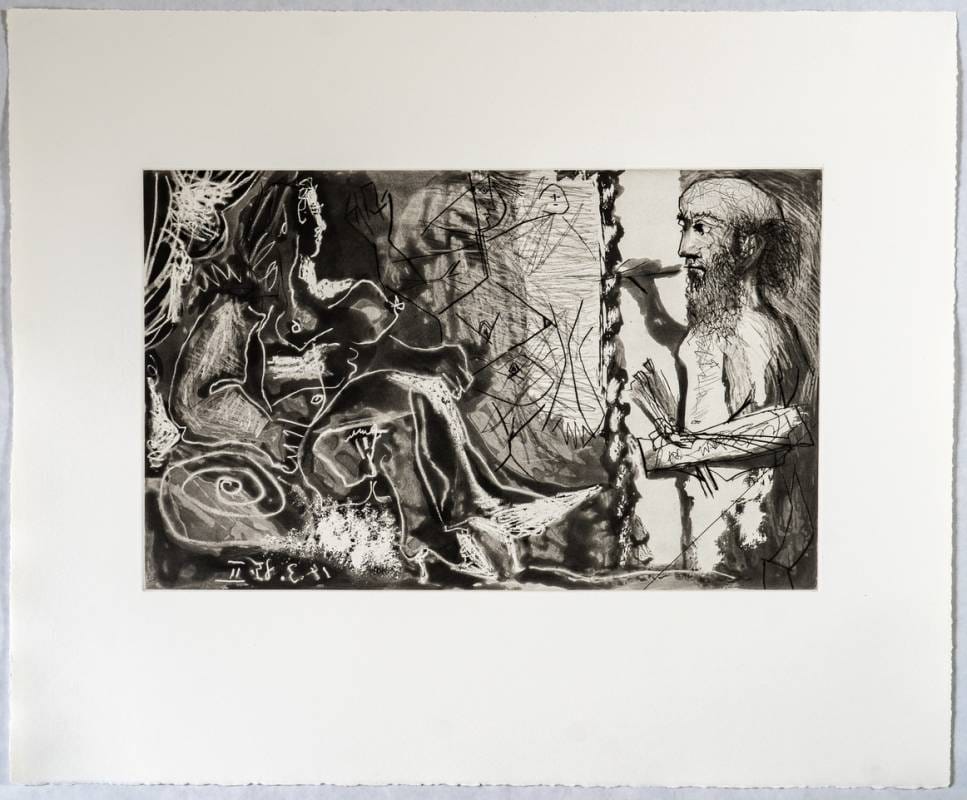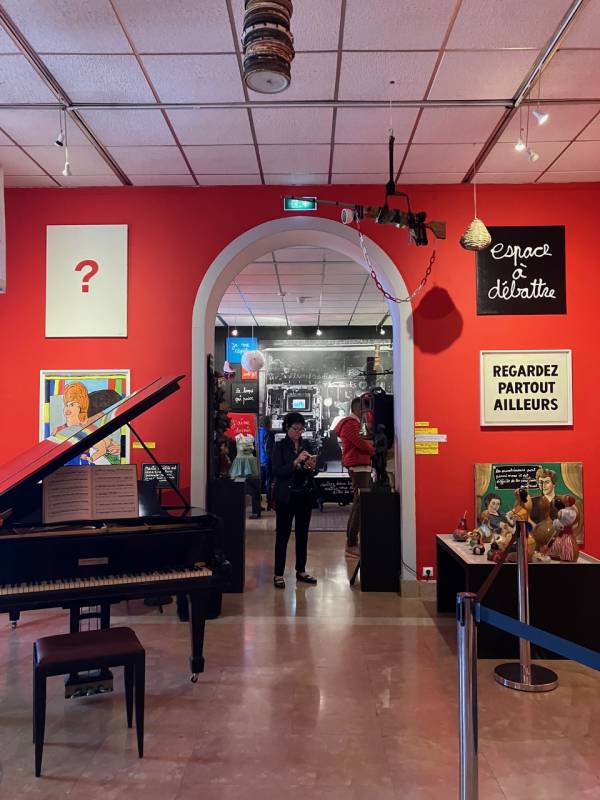Picasso’s engravings at the Mougins Art Centre
Until January 7, 2024
A new Art Centre has just opened its doors in the heart of Mougins village. This space dedicated to modern and contemporary art in a historic building is thoroughly renovated to welcome its artists and visitors. For its opening, for the 50th anniversary of the cubist master’s death, its first exhibition features a collaboration between Picasso and the renowned engraver, Aldo Crommelynck. This technique used during his Mougins years is particularly characteristic of the “late Picasso”.

Hundreds of engravings were thus produced, certain around the exhibition’s theme, “La route du Cuivre” (The Copper Road). Several photographs witness this four-handed creation. Aldo Crommelynck closely worked with Picasso in 1963–1970 in the cubist master’s last residence, Notre Dame de Vie.


These touching images are now part of the history of art. The complicity between Picasso and the Crommelynck brothers was intense and fertile indeed. An unwavering friendship was born out of that. For over ten years this exceptional relationship contributed to Picasso’s last years being particularly fruitful. The artist’s favourite themes are thus revisited in these engravings. Fist and uppermost, a woman, omnipresent in her sensuality, then the artist’s studio and a dreamlike atmosphere flirting with surrealism. A bit of a last-minute breviary.
Pablo Picasso / Aldo Crommelynck
La route du Cuivre – Mougins 1963-1972
Une histoire de gravure
Centre d’Art de Mougins
Place du Commandant Lamy, Mougins village
Modigliani at the Orangerie in Paris, with his dealer and his women
Until January 15, 2024
Pale, as if deprived of any gaze, enigmatic, fascinating faces. They may seem empty, and yet radiating an extraordinary fullness. All of Modigliani’s art, poetic, restrained, audacious and rebellious, resides in this unique vision of a human face. Born in Italian Livorno, the artist was mainly devoting himself to sculpture at the moment he encountered his dealer to be, Paul Guillaume.

More than a 100 years later after this meeting in 1914, a unique exhibition at the Parisian Orangerie is highlighting the importance of this relationship in Modigliani’s artistic evolution. A selection of masterful works includes two paintings from the famous Monaco-based Nahmad collection. “The Beautiful Grocer” and “The Woman with the Black Tie” were created during the period when, encouraged by Paul Guillaume, Modigliani abandoned sculpture for painting.


David Nahmad has shared his wonder as to the second painting acquired in 1994: “I was fascinated by the unexpected side of this painting and seduced by this woman’s dreamy appearance.”
“Modigliani on the French Riviera, between Nice and Cagnes-sur-Mer” by Alain Amiel traces yet another of the artist’s connections to the area. The book sold at the Museum shop, explores his Riviera period which until now had been little documented.
One of the most outstanding figures in the 20th century, Modigliani is sharing this exhibition with artists and women who mattered to him during his lifetime. Definitely a must-see.
Amedeo Modigliani. Un peintre et son marchand
Musée de l’Orangerie
Jardin des Tuileries
Place de la Concorde, Paris
Mark Bradford at Hauser & Wirth Monaco, simply breathtaking!
Until February 10, 2024
An immaculate space, bathed in a well of light, is entirely taken over by this committed artist. Having created an in situ installation at the Hauser & Wirth in Monaco, Mark Bradford is leaving visitors literally speechless. Inspired by the medieval tapestry series “The Hunt for the Unicorn” where animal and plant species, predators and prey jostle, the artist projects this disturbing theme into the world of today. His work sadly has a burning relevance, drawing a parallel between the contemporary world and “The Dark Ages”. “Nobody Knows the Trouble I’ve Seen” is highlighting an obscurantism we were well hoping to leave behind.

Mark Bradford is taking over the walls, reconstructing the landscape. He is accumulating layers of paper and putty, using his typical techniques of sanding, tearing and oxidation. Paintings are hanging down from the walls covered with paper work. Black globes suggesting different continents are suspended from the ceiling. Varying in size, these globes allude to the multiple social, political and economic contexts we may all be exposed to in the world of today.

“My paintings are conversing with the Middle Age tapestries. That’s what comics of nowaways are about. I speak out against labels like a woman should be doing this type of art, a black person that…Here in Europe, I see that it all revolves around the nations. In the United States, skin colour precedes and determines your destiny… We must assert ourselves as individuals, it is the human being that precedes!”

This black American artist whose pavillion particularly stood out at the Venice Biennale in 2017 was there to personally open his exhibition. He claims not to be defined by any norm and wants to shout out where, according to him, “artists only speak softly since they are taught to stay behind the scenes”.
Immersed in his work, we totally understand the message, leaving the gallery stunned and trembling. A strong, compulsory and dazzling art indeed.
Mark Bradford
Nobody Knows the Trouble I’ve Seen
Hauser & Wirth Monaco
One Monte-Carlo, Place du Casino, Monaco
“We are all crazy” with Ben at the Native Art Museum in Nice
Until May 6, 2024
Just imagine! An entire museum “given” to Ben to play with, to unveil his peculiar ideas, taking us into his delirious world… That’s what it is. The Anatole Jakovsky International Native Art Museum has long become a playground for the most unpredictable School of Nice artists. This time, Ben is giving a free reign to his imagination!

500 square metres for a colourful carte blanche”. Some 200 of Ben’s creations rub shoulders with those of his many artist friends, happily interacting with Anatole and Renée Jakovsky’s collection constituting the museum funds.
“On est tous fous” (We are all crazy) is more than just a comment, but a true profession of faith the artist is sharing with his audience, invited to get take part in the exposition through a suggestion box.
“I believe in a principle that every artist has a grain of madness he wishes, but does not dare reveal”. Certain of that, Ben takes over every corner of a museum revisited according to his own image.

© Nicole Laffont
From the very entrance, the wall is all tagged with the artist’s ever recurring questions “Is it art or not art?”, “Is there anything beautiful or ugly?” and affirmations like “I seek the truth”.
He learns his own truth through the so called Diogenes syndrome. Ben doesn’t throw anything away, but accumulates papers, everyday objects, photos, tools, the works and ideas of his artist friends. Browsing through different rooms, we realize just how much his works escape any theory, any classification. Come and visit this exhibition to grasp the extent of this approach, in no way rational. Seeing is believing. Don’t miss out.

© Nicole Laffont
On est tous fous
Musée International d’Art Naif Anatole Jakovsky
Château Sainte-Hélène, Av de Fabron, Nice









